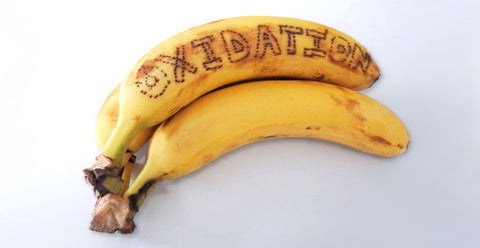All epoxy resins are NOT created equal.
Chances are if you're reading this post. have you had a beautiful piece of art turn yellow after using a resin product not specifically formulated for use in creative projects. Of course, very boring.
Here's why it happened and how to avoid it next time.

The effects of UV light on epoxy resin
If you don't use ArtResin epoxy resin, your work is in real danger of discoloration from the natural environment. UV light is responsible for changes to cured epoxy resin over time. When UV light hits the resin - either directly or indirectly - it breaks down the polymers. Although this degradation from UV light is a natural process (UV light is usually always harmful to anything on Earth over time), it causes observable, unwanted, aesthetically displeasing properties, such as:- gloss loss
- delamination
- cracking
- chalk
- YELLOWING
A UV stabilizer can be added to epoxy resin formulas to mitigate these effects. UV stabilizers are very effective in preventing gloss loss, delamination, cracking and chalking, but they only delay discoloration. In other words, yellowing is still inevitable with a UV stabilizer alone. Yellowing first appears as a light tone all over and then gradually darkens until it reaches a dark brown-yellow shade. Yellowing will be accelerated with exposure to UV light. A piece of plastic placed outside will generally reach its dark brown-yellow color within 24 hours. Artwork stored indoors will generally begin to discolor within 6 months to a year if it was coated with a resin product that only contained a UV stabilizer. If the resin contained no UV stabilizer at all, it will reach a dark yellow much faster, within about 2-3 months. Discoloration has also been demonstrated in pieces that have been kept in total darkness.
* It should be noted that yellowing can occur as a result of an unwanted interaction between titanium dioxide (found in white pigments) and ANY brand of epoxy resin.
All epoxy resins are NOT created equal
There are many, many uses for epoxy resin, just one of which is as a clear coating for artwork and other creative applications. Many epoxy resin products on the market are sold as adhesives and most are intended for industrial use, not home/studio use. Many resins are made for the marine industry because epoxy is a durable, waterproof product. In most cases, epoxies are not formulated specifically to maintain clarity over the long term, as artists require. Furthermore, most resins are considered a hazardous material due to their chemical composition; they are intended for use in industrial environments where hazmat suiting is readily available and required. Any resin that yellows quickly is not adequately formulated for use over artwork. Any artist considering using resin over their artwork should definitely choose a product that has been formulated for creative purposes, namely that it is both UV and HALS stabilized and is considered non-toxic when used as directed and safe for home use in a well-ventilated area.
See our safety data sheet for more information.

How to protect your artwork from yellowing
UV stabilizers are not enough to prevent yellowing in epoxy resin. If you're coating artwork – or anything creative, special and important – you'll need a product that contains an additive called "HALS", in addition to a UV stabilizer. HALS stands for Hindered Amine Light Stabilizer . Its job in the formula is solely to deal with yellowing. How does it do this? HALS scavenges radicals produced by exposure to UV light, reducing the degradation cycle that causes yellowing. Its protective capabilities have been demonstrated time and time again since its introduction in the 1960s. A UV stabilizer is still necessary to protect against other problems caused by UV light degradation, but HALS is the primary agent that works to counteract yellowing.
...So which epoxy resin product is specially formulated for creative projects? which contains both a HALS and a UV stabilizer? which has been found to be non-toxic when used as directed and safe for home use? which is a light mixing ratio of 1:1 and which gives a beautiful, glossy finish? It's ArtResin.
Why epoxy hardener sometimes changes color in the bottle
If you have found that your epoxy hardener has discolored in the bottle, this is due to oxidation, not UV light. The hardener yellows faster in liquid form once the bottle has been opened because it has been directly exposed to oxygen, and this will always be more noticeable in larger containers (just like how the ocean looks blue but a cup of water looks clear). It may still turn a very faint yellow if unopened due to the HDPE plastic bottles it comes packaged in breathing a little, allowing oxidation to occur. For this reason, epoxy resins will always have a shelf life. Once a product has started to yellow in the bottle, it can still be used (ie it will still cure properly). It will always look less yellow on a piece due to having to mix with an equal part of the resin to dilute it, and the product will be spread out in a thin layer making any observable discoloration much less visible .


